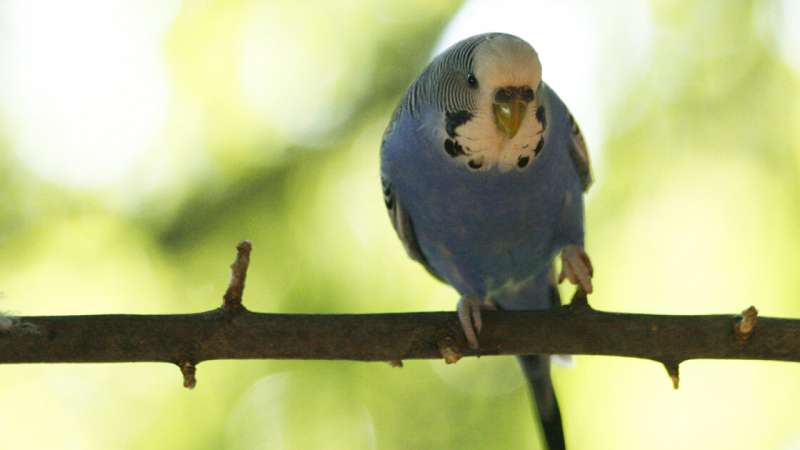
How do birds avoid collision when flying in dense foliage and other cramped environments with many obstacles? And what does flying in such complex environments entail for the birds? These were the questions Per Henningsson of Lund University in Sweden pondered before engaging the help of the family's own pet budgie to get some answers. His study has now been published in Royal Society Open Science.
The pandemic restrictions encouraging everyone to work from home marked the starting point of the study. Per Henningsson involved both his wife Teresa and his seven-year-old daughter Alice in the research and, not least, the family's one-year-old female budgie, Poppen. In a hallway at home, the Henningssons constructed obstacles with openings of varying width—everything from 75 centimeters down to 7 centimeters. Using high speed cameras, Henningsson filmed Poppen's flight path in 3D, and calculated how she slowed down and negotiated her way through the obstacles.
"The wingspan of a budgie is around 30 centimeters, so it was really impressive to observe that Poppen managed even the smallest opening of 7 centimeters and that her flights were not affected at all until the opening was narrower than her wingspan," says Per Henningsson.
The study shows that the bird adapts its speed precisely to the width of the opening, which means that it is able to assess what is required to make it through the gap. As it approaches the narrowest opening, it almost halves its speed and gains height before the obstacle, which probably means that it predicts the loss of altitude associated with slowing down and pausing its wing beats as it flies through the gap.
However, the adaptations needed to make it through narrow gaps come at a price. Firstly, it obviously takes longer to fly between two points if flight speed is reduced and, secondly, it requires a lot of extra energy as the bird is forced to fly at a less than optimal speed while increasing the rate of its wing beats as it slows down. Likewise, extra energy is required to accelerate again once the bird has made it through the narrow opening.
This is not the first time studies have been carried out to see how birds manage to fly through openings of various widths, but no previous study has challenged a bird with such narrow gaps (7 centimeters). Moreover, very few studies have examined the cost to the bird when it flies in complex environments. Besides the new knowledge, Per Henningsson thinks the findings could help in the development of future drones, machines that must negotiate narrow spaces with many obstacles and tight passages.
"I am quite proud of myself for having been resourceful during a period in which I could not access the lab and therefore conducted research on what I had at hand in my own home. Having said that, I would not say that this happened as a result of the limitation of working from home, but rather the exact opposite. It was an opportunity that emerged when I noticed how accurately Poppen flew through small openings here at home," explains Per Henningsson.
Henningsson stresses that the study has limitations, as it involved just one individual. However, the intention was never to map the flight behavior of budgies in general, but rather to use Poppen as a model for understanding how birds solve the problem of flying in complex environments and what costs may be involved.
"It would definitely not have been easier or better to conduct the study in the lab; in fact I am convinced that the only reason we succeeded in getting the bird to execute these demanding flights is that it is tame and comfortable in its usual, familiar environment, handled by people it knows well. That is why it was crucial that my wife and our daughter were also at home, as the study could not have been conducted without them."
Explore further
Citation: Pandemic restrictions enable unique bird study (2021, August 31) retrieved 31 August 2021 from https://ift.tt/3zClYyI
This document is subject to copyright. Apart from any fair dealing for the purpose of private study or research, no part may be reproduced without the written permission. The content is provided for information purposes only.
"bird" - Google News
August 31, 2021 at 08:16PM
https://ift.tt/3zClYyI
Pandemic restrictions enable unique bird study - Phys.org
"bird" - Google News
https://ift.tt/2s1zYEq
https://ift.tt/3dbExxU
Bagikan Berita Ini














0 Response to "Pandemic restrictions enable unique bird study - Phys.org"
Post a Comment